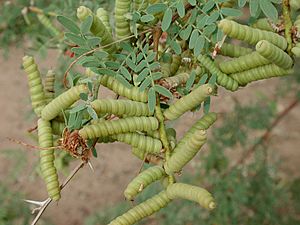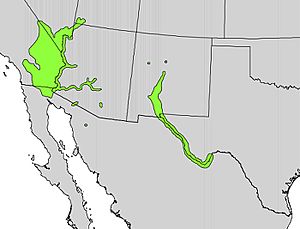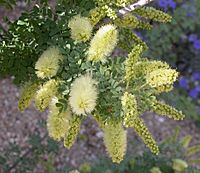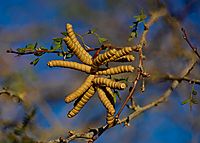Screwbean mesquite facts for kids
Quick facts for kids Screwbean mesquite |
|
|---|---|
 |
|
| Mature seedpods (legumes) | |
| Scientific classification | |
 |
|
| Natural range |

Prosopis pubescens, often called screwbean mesquite, is a type of flowering plant. It is a shrub or small tree that belongs to the pea family, known as Fabaceae. This plant naturally grows in the southwestern United States and northern Mexico. You can find it in states like Texas, Arizona, New Mexico, California, Nevada, and Utah. In Mexico, it grows in Baja California, Chihuahua, Coahuila, and Sonora.
Contents
What Does Screwbean Mesquite Look Like?
This plant can grow up to about 7 meters (23 feet) tall. It has light brown bark and usually has short, straight spines that are 1 to 3 centimeters long. Its leaves are twice-compound, meaning they have many small leaflets.
In spring, you'll see many small, yellowish flowers. These flowers grow in long clusters called spikes. The most interesting part might be its seedpods. They are tightly twisted, up to 5 centimeters long, and look very much like screws! This unique shape might help protect the seeds from animals that like to eat them, such as bean weevils.
The seeds of the screwbean mesquite need a special process to start growing. They usually sprout after being eaten by animals. When the seeds pass through an animal's digestive system, their tough outer shell gets scratched. This scratching, called scarification, helps them germinate or sprout later.
Where Does Screwbean Mesquite Live?
Screwbean mesquite loves to grow along streams and in valleys within desert areas. It especially likes damp or salty soil. You'll often find it growing with other plants common to these places, like arrowweed and tamarisks. It can also be found in dry lakebeds, called playas, and other areas with alkaline soil.
This plant, along with other mesquite species, forms important woodlands called "Mesquite Bosques." These woodlands are a common type of habitat in the desert southwest region.
Many animals enjoy eating the seedpods of the screwbean mesquite. These include different kinds of birds, rodents, and even coyotes. Many bird species build their nests and rest in these trees. Small mammals also find shelter in the thick, dense stands of mesquite.
How Do People Use Screwbean Mesquite?
Food Uses
Just like other Prosopis plants, the screwbean mesquite has nutritious seedpods that people can eat. The Pimas, a Native American group, used to cook the pods in dirt-covered pits for several days.
Mesquite has been a traditional Native American food for hundreds of years. People used it to make meal, cakes, and syrup. This high-protein food is also rich in important nutrients like calcium, magnesium, potassium, iron, and zinc. It also contains a lot of the amino acid lysine.
Mesquite is high in fiber, has a moderate amount of sugar, and is about 8% protein. It has a sweet, rich flavor that tastes a bit like molasses or caramel. This makes it great for adding to smoothies or other drinks, especially with cacao or maca. The fruits can even be used as a coffee substitute.
Wood Uses
Native Americans found the wood from screwbean mesquite very useful. They used it for building, making tools and weapons, and as firewood. The wood is strong and attractive, so it can also be used in woodworking. Some Native American groups also used the bark from the roots to create a treatment for wounds.
See also
 In Spanish: Mezquite dulce para niños
In Spanish: Mezquite dulce para niños
Images for kids
-
Mature seedpods (legumes)




